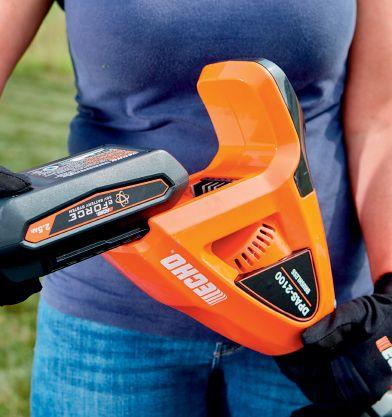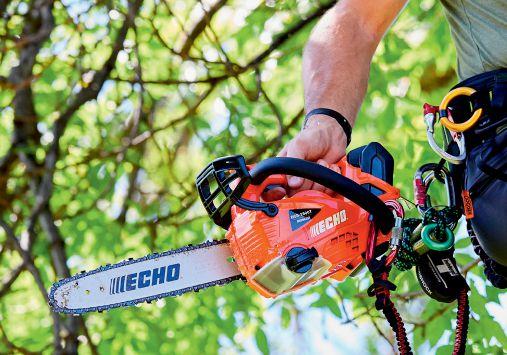

Reliability that counts

NEW KMA 135 R BATTERY KOMBISYSTEM

ADAPTABLE SOLUTIONS FOR PROFESSIONALS.
The KMA 135 R battery-powered KombiEngine is a versatile tool that can efficiently loosen soil, blow debris, trim grass and hedges, prune trees, manicure paths and gardens. The use of one powerhead with 14 separate attachments welcomes more storage space and less maintenance of multiple tools. The KMA 135 R is lightweight, emission-free and quiet in operation. The effortless KMA 135 R features a brushless motor and provides the performance that landscapers and groundskeepers require to complete their work in a timely manner. The ergonomic loop handle provides greater comfort and less user fatigue. Built with three power settings to offer the momentum required for a task, while conserving battery energy and longer battery runtimes.

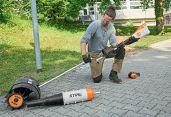
Battery Power. Made by STIHL.
SPECIFICATIONS
PRO-FLEET COMMERCIAL LANDSCAPE PROGRAM
STIHL’s Pro-Fleet Commercial Landscape Program is designed to provide commercial landscapers a volume discount on major purchases of five or more landscaping power tools. Visit your STIHL Dealer today to find out more and take advantage of the savings!

Scan code for more product information or visit www.stihl.ca
① Battery and charger sold separately. ② Weight without battery.
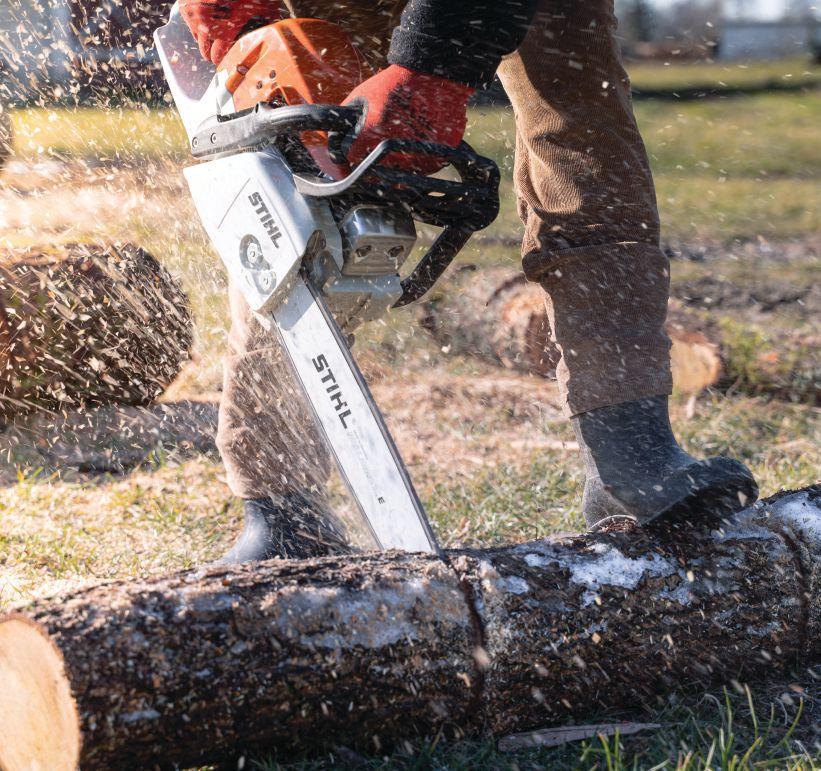

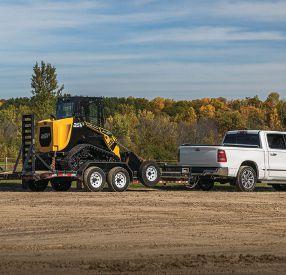

By Mike Jiggens
The return of live, in-person events
The Canadian turfgrass industry’s trade show and conference circuit is set to kick off for another season in January, with some events returning to live, in-person affairs and others holding on for another year to COVID-19-friendlier virtual offerings.
While industry conferences south of the border returned months ago to in-person events, Canada has taken a more cautious approach before swinging its doors wide open. Already in the U.S., we’ve seen delegates flock to such events as the Snow and Ice Management Association (SIMA) series of gatherings in late summer and the GIE+EXPO – to be rebranded next year as Equip Exposition – conference and show in October in Louisville, Ky. The latter event, in fact, exceeded both its 2019 and 2018 attendance numbers.
These events likely had little in the way of Canadian representation as attendees from north of the border would have had to fly to those U.S. destinations. Now that the border has opened up for Canadian land traffic to cross into the U.S., this will likely change things moving forward.
Canadian attendance at the coming Golf Industry Show, slated for February in San Diego, is apt to be strong as international travel confidence continues to build amid the swelling numbers of fully
vaccinated Canadians.
One of Canada’s first industry events to annually kick start each new year is Landscape Congress, which is typically held in early January in Toronto. Canada’s largest horticultural trade show and conference has adopted a hybrid approach for 2022, however, with the trade show itself returning to a live and in-person happening while the conference, including its array of education seminars, being offered virtually for a second straight year.
Over the course of the exact same three days as Congress’ virtual conference is the Canadian Golf Course Management Conference in Toronto – a co-production of the Canadian Golf Superintendents
Attending a trade show virtually is not the same as being there in person.
Association and the Ontario Golf Superintendents Association – which is being presented live and in person for the first time since just before the pandemic began.
The Western Canada Turfgrass Association has also announced it is returning to a live, in-person conference in mid-February in Penticton, B.C.
Organizers of the Ontario Turfgrass Symposium, on the other hand, have opted to keep their event going virtual for another year, according to the OTS website.

Whether these organizations have chosen to take baby steps on their way toward full re-openings – perhaps in 2023 – or they’re ready to go now, we’re seeing a gradual return to what we had taken for granted before 2020.
The number of active COVID cases is still creeping upwards in some areas, but the number of fully-vaccinated Canadians is also on the rise. Those who wish to attend any of these industry events in person will have to prove they’ve been fully vaccinated.
Only time will tell how well these in-person conferences will be attended. There is likely a mixed bag of would-be attendees who are either anxious for a return to their pre-pandemic experiences or who are willing to wait it out another year and see how things stand by then.
It’s been 21 months since the pandemic hit – almost enough time to forget what “normal” is or what it used to be. Meeting up with familiar faces (if they can be recognized behind their masks) in familiar settings will probably be therapeutic for many, not to mention productive in terms of networking opportunities.
Attending a trade show virtually is not the same as being there in person. Industry professionals want to be able to “kick the tires,” get under the hoods of mowers and other heavy equipment, and physically place their hands on the wares exhibited. That can’t be done virtually.
Nevertheless, CGSA, OGSA, Landscape Ontario and WCTA should be celebrating successful conferences in 2022.
www.turfandrec.com
Reader Service
Print and digital subscription inquiries or changes, please contact Anita Madden, Audience Development Manager Tel: (416) 510-5183 Fax: (416) 510-6875 email: amadden@annexbusinessmedia.com
Mail: 111 Gordon Baker Rd., Suite 400 Toronto, ON M2H 3R1
Editor Mike Jiggens mjiggens@annexbusinessmedia.com
National Advertising Manager Rebecca Lewis 519-400-0322 rlewis@annexbusinessmedia.com
Nashelle Barsky 905-431-8892 nbarsky@annexbusinessmedia.com
Account Coordinator Mary Burnie 519-429-5175 mburnie@annexbusinessmedia.com
Group Publisher Todd Humber thumber@annexbusinessmedia.com
COO Scott Jamieson sjamieson@annexbusinessmedia.com
Printed in Canada ISSN 1186-0170
PUBLICATION MAIL AGREEMENT #40065710
SUBSCRIPTION RATES
Published 7 times a year – Jan/Feb, March, Apr/May, June/July, Aug/Sept, October, Nov/Dec Canada – 1 year $35.00; 2 year $45.00 3 years $55.50 (plus applicable taxes HST 86717 2652 RT0001
Occasionally, Turf and Recreation will mail information on behalf of industry related groups whose products and services we believe may be of interest to you. If you prefer not to receive this information, please contact our circulation department in any of the four ways listed above.
Annex Privacy Office privacy@annexbusinessmedia.com Tel: 800.668.2374
No part of the editorial content of this publication may be reprinted without the publisher’s written permission © 2021 Annex Business Media. All rights reserved. Opinions expressed in this magazine are not necessarily those of the editor or the publisher. No liability is assumed for errors or omissions.
All advertising is subject to the publisher’s approval. Such approval does not imply any endorsement of the products or services advertised. Publisher reserves the right to refuse advertising that does not meet the standards of the publication.




It’s Zevolution: the evolution of the ZTrak™ 900 Series. Our engineers never rest on their laurels. Whatever




Ever since the first Z900, we’ve always kept the pedal down in terms of product improvements. We don’t look back: we look forward. For us, there’s always a better Z900 around the corner.
We do this because we know you’ve got places to be, lawns to mow, jobs to finish. And John Deere is right there every step of the way, with not only great products, but also NEVERSTOP™ Services and Support –from financing to parts and service, even loaners.
We all have got a job to do. And ours is making sure you have exactly the tools you need to do your job right, the first time and every time.





John Deere’s green and yellow color scheme, the leaping deer symbol, and JOHN DEERE are trademarks of Deere & Company.
Club at Bond Head under management of GolfNorth
The North and South courses at the Club at Bond Head are now under the management of GolfNorth.
GolfNorth, which operates 37 courses in Canada, has entered into a long-term agreement to lease the Club at Bond Head, which is situated near Aurora, Ont.
Bond Head is frequently ranked among Canada’s top 100 golf courses by ScoreGolf. The South Course opened in 2005 while the North Course opened a year later.
Insurance rates soar for snow contractors in Calgary area
Snow removal contractors in Calgary are facing significant insurance hikes this season – in some cases for less coverage – and some are being outright denied coverage.
The situation is putting some contractors out of business while others are being forced to pass the increases on to their customers. Others yet are considering declining work at slip-andfall areas that are deemed high risk.
One local contractor was told his rates were to jump to $42,000 annually from $8,000.
Police ID suspects connected to sports field vandalism
Niagara Regional Police have identified suspects in the aftermath of two Niagara Falls baseball fields that had been torn up by off-road vehicles in late October. Damage to the fields is estimated at $10,000. The vandalism included damage to the sod, clay and irrigation system at the Patrick Cummings Memorial Sports Complex.
Police have not disclosed the names of the suspects, nor have any arrests been made.
The investigation is continuing.

Leadership program promotes women in the skilled trades
A new program is being launched by The Canadian Apprenticeship Forum that is aimed at empowering skilled trades advocates at the June 2-3, 2022 Supporting Women in Trades Conference, to be held in St. John’s, NL.
The National Leadership Development Program for Women in the Skilled Trades is being developed in partnership with the Office to Advance Women Apprentices, and will be available to all tradeswomen, including Indigenous peoples, LGBTQ2S+ individuals, immigrants, persons with disabilities, and those from racialized groups.
$10,000 damage estimate to Niagara
Participants will be guided by subject matter experts, learning effective strategies and gaining practical tips to empower them as leaders in their workplaces and the broader community. Special attention will be paid to how the learning can be applied in a skilled trades workplace. With improved knowledge about strategies to mentor, take on leadership roles on the job site and within their unions, communicate, resolve conflict, and speak with confidence, tradeswomen can be leaders and inspire young girls and other women to thrive in the skilled trades.
The National Leadership Development Program for Women in the Skilled Trades will be offered at no cost to tradeswomen and offered in a safe and respectful setting. CAF-FCA and Office to Advance Women Apprentices will work with industry, trades unions, government, and training institutions to support development and administration costs. Women are marginalized in skilled trades workplaces and experience barriers. Female apprentices report more difficulty finding employer sponsors and have lower apprenticeship completion rates than males (Prism, 2021). As a result, non-completing women cannot access the high-paying, full-time and leadership position work associated with certification in the trades.
A positive work environment and support from peers are key to program retention, but, in the absence of these women, apprentices report poorer mental health than male apprentices (CAF-FCA, 2020) contributing to a lack of confidence and sense of isolation.
For more information about the program, visit switcanada.ca or contact France Daviault: france@ caf-fca.org.
Find the latest turf-related news, stories, blogs and analysis from across Canada, and access our forum . . . www.turfandrec.com
Number of GolfNorth operations in Canada
ball field
FUTURE BUSINESS GROWS IN SILENCE








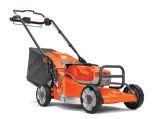

Today’s green spaces need modern care. Husqvarna’s lightweight, powerful and durable battery tools are long-lasting, quick to change and have zero direct emissions without compromising on performance. They are also much quieter than their gas equivalents so you can start earlier, finish later and get more work done – without disturbing the surroundings. More and more professionals are switching to Husqvarna so they can grab a piece of the action. Visit Husqvarna.us/demo to sign up for a free demo and you’ll see what we mean.
Battery power: It’s catching up, but gas still has a place
Although gas blowers meet noise and emission standards, they’re still depicted as the ‘bad guy.’
By Mike Jiggens
Arecently passed law in California will ban the sale of new gasoline-powered landscaping equipment by Jan. 1, 2024. The legislation encompasses blowers, mowers, trimmers, chain saws and other small-engine equipment, and is aimed at reducing the state’s overall emissions of pollutants.
Can similar legislation be far behind in Canada?
One product that tends to be singled out as the “bad guy” among gasoline-powered landscaping tools is the leaf blower, which is being attacked on two fronts – for its emissions and its noise output.
“We’ve spent literally millions to reduce that noise level and, when people criticize blowers, it’s probably more along the lines of an electric than a gas,” Hugh Munn, Ontario and Western Canada sales manager for Stihl Limited, said. “We’ve dramatically reduced the hydrocarbons that a blower produces. Stihl’s best-selling backpack blower produces 17 grams per kilowatt-hour. Going back to the late 1980s or early ‘90s, a comparable model would have produced about 185 grams.”
Although vast improvements have been made to gas-powered blowers in recent years, professional landscapers aren’t as

Battery-powered leaf blowers are suitable for landscapers’ day-to-day use, but may not offer the power required that gas models can deliver when needed for heavy, wet leaf cleanup in the fall.
quick to embrace their battery-powered counterparts as they have with other landscaping tools run by battery.
Jason Wilk, senior product manager at Echo Inc., said battery-powered landscaping equipment has come a long way over the years, but a performance gap still exists with blowers.
“The way blowers draw power, there’s still a pretty big gap in performance from battery-powered blowers to gas,” he said. “There’s a huge gap in blowing performance, but also in run times. It’s the one application where gas truly doesn’t have an equivalent battery version of it.” Wilk said lower-power applications,
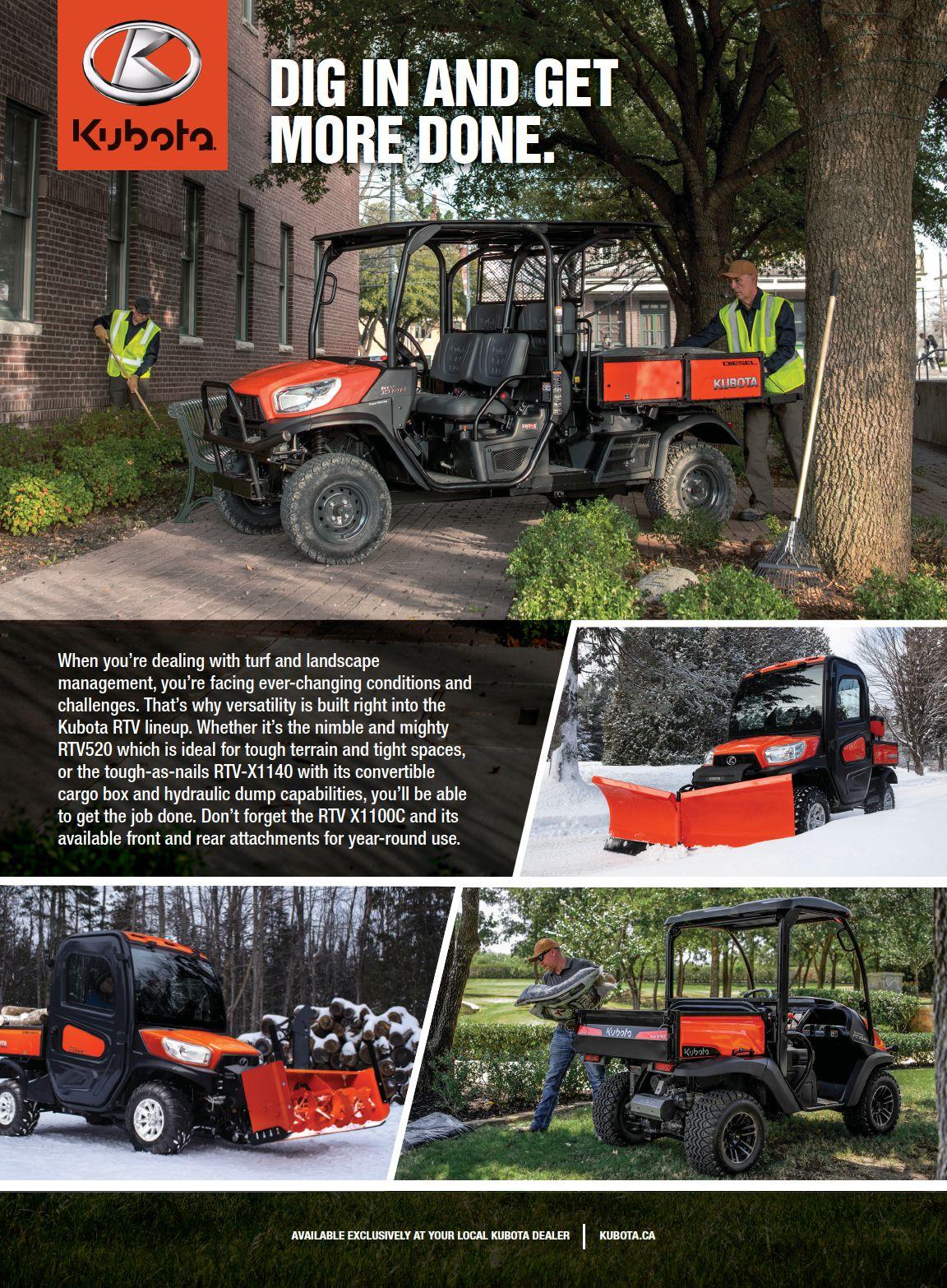
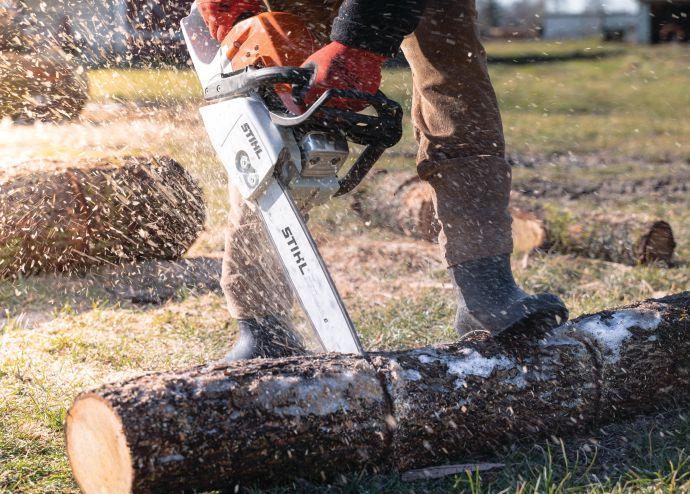
such as hedge trimmers and some string trimmers, achieve similar performance when comparing battery power to gasoline. But, blowers need a significant amount of power to move their fan, and battery-powered blowers don’t provide the same performance, run time and ease of refueling as gas-powered models.
Keith Coultrap, director for Husqvarna’s professional brand, said battery-powered blowers can achieve the day-to-day needs of professional landscapers, but added they may not have the power required for the fall cleanup of wet and heavy leaves that gas units provide. He said the advantage of battery-powered blowers and other tools is that time isn’t wasted with constantly starting and stopping throughout the work day. They don’t require a pull start and are much less “finicky” in colder weather.
Impact of switching to battery
The City of Vancouver is asking for submissions to potentially trend toward batteries from gasoline in powering landscaping equipment. Munn said municipalities that have considered bans on gasoline-powered tools, such as blowers, have found their own parks and recreation staff have said labour costs are likely to increase as a result.
“We have to remember it’s a hell of a lot easier to blow leaves than it is to rake leaves, and you’ve got repetitive motion injuries to the user,” he said. “A lot of landscapers just won’t rake leaves. They refuse. They won’t do it. They see it as a menial task.”
West Vancouver has invoked a noise restriction on blowers, but gas blowers aren’t banned as long as they meet published noise limits, and then must be labeled as such.
“We do sell what are called low-noise, gas-powered blowers,” Munn said.
The City of Vancouver is contemplating whether it’s time to switch its municipal equipment fleet from gas to battery.
Munn said Stihl is supportive of municipalities’ desire to reduce their noise and emissions outputs, adding, “The issue we have as a manufacturer is that what is being communicated is truthful.”
He said he had attended a meeting where an individual claimed backpack blowers generate more pollution than seven Raptor trucks.
“That’s just nonsense,” Munn said, suggesting such data was 20 years old. “Our handheld power equipment gets a bad rap because we look at stuff that was built in the ‘70s.”
He reiterated that governmental man-
dates to reduce emissions, in both Canada and the United States, have resulted in millions of dollars spent by the industry to comply.
Stepped-up R&D
John Powers, director of product management at Echo Inc., said research and development efforts have been stepped up considerably in order for gasoline-powered equipment to become emissions and noise compliant.
“We’ve been involved in making blow emissions equipment ever since the first regulations came into effect back in the mid-to-late 1990s,” he said. “Since that time, we’re reduced emissions on our gas equipment by over 90 per cent. It’s a huge amount since that time period.”
Powers added that in addition to stepping up its emissions reductions, Echo has greatly reduced the noise output of its gasoline-powered blowers.
“We still have several low-noise gas blowers today in our lineup,” he said.
Coultrap said Husqvarna will continue to offer both gasoline and battery-powered tools to its landscaping customers “so that they can choose what they want, based on their unique needs and their unique market.”
He added that until landscapers’ needs can be fulfilled by a complete battery lineup, both gasoline and battery-powered equipment will continue to be offered to professionals.
A number of commercial and residential customers of landscaping firms have become more environmentally conscious in recent years and are making their voices heard in some circles. Mike McConnell, national sales manager for Echo Power Equipment (Canada), said TLC Landscaping in London, Ont. has entire crews dedicated as cordless operators.
“While we’re seeing a shift, we’re definitely seeing more and more crews picking up portions of their trucks and – with TLC – an entire truck, so they’re doing dedicated jobs.”
Coultrap said there are several commercial customers with sustainability agendas who purposely seek out landscaping companies that offer work done using bat-
Noise and emission-compliant gas-powered equipment and more powerful battery-powered tools give contractors a choice to meet their specific needs.
tery-powered equipment.
One of the advantages landscapers are realizing about battery-powered equipment is the reduced amount of maintenance required in comparison to gas-powered tools. The lack of air filters, fuel filters, carburetors, fuel tanks and not having to mix gas and oil are viewed as pluses in battery’s favour.
The key to the performance of battery-powered equipment lies with the battery itself.
“The challenge there is to come up with newer and better batteries so that the user gets a longer operating time,” Munn said, adding Stihl is introducing a “wafer-style” battery configuration. “The premise is the same. You just layer them. You get more energy out of that configuration than the cylinder configuration.”
Thinking of the future
The mindset among younger landscapers tends to differ from that of older generations, Munn said, suggesting they are more environmentally conscious about the future.
“Landscape contractors are much more open to battery tools than they were 10 years ago because the battery tool has improved a lot, and they’re starting to realize they can be just as productive.”
Powers said landscape contractors also find working with battery-powered equipment to be advantageous on hotter days.
“In situations like that, landscapers typically want to start very early in the morning so they can be done before the peak temperature in the middle of the day, and the battery equipment helps them to start earlier in the day without disturbing anyone in a residential environment,” he said. “That allows them to finish earlier in the day so they can avoid the peak heat and have less fatigue.”
The amount of energy that can be stored in a battery is limited, but lithium-ion battery technology continues to improve, Powers said.
“As that continues to increase, I think adoption by professionals is only going to increase,” he said, noting battery-powered hedge trimmers are likely to experience the highest rate of growth since they don’t require the same amount of power as other tools.
Migration toward battery
Munn said he believes more landscapers are migrating toward battery-powered equipment, adding he anticipates the demand for battery-powered tools will be significant as we approach 2030 – the year Canada has targeted for a 30 per cent reduction in emissions from 2005 levels.
“We’re seeing significant changes each and every year,” he said. “Our battery business has gone up dramatically.”
If a landscaper was looking for a particular battery-powered piece of equipment 10 years ago, he might have had difficulty finding what he wanted, Munn said. Today, however, it can be found readily.
Jack Easterly, product manager for Husqvarna’s professional brand, said he figures there will be more performance, less weight and better efficiency in battery equipment over the next five years.







Select the right seed for your turf cover
Whether it’s a home lawn or sports field, seed choice will impact pest management, mowing heights and cultural practices
By Mike Jiggens
Selecting the right seed is crucial if the goal is to establish a resilient lawn that requires minimal pest management. When selecting turfgrasses, it’s actually genetics that are being selected, says the director of the Guelph Turfgrass Institute.
Addressing the topic during the winter’s virtually delivered Ontario Turfgrass Symposium, Dr. Eric Lyons said turf breeders talk about “G by E interaction,” or genetics by the environment. Different cultivars respond differently to such environmental factors as shade, heat, drought, cold temperatures, ice, short days, biotic pressures, insects, weeds and disease.
“With turf, we have to really pay attention to management because the management we put on the turf changes the environment greatly,” he said.
Among the management tasks that have a particular bearing are mowing heights and mowing frequency, he said, adding some turf species respond well if the one-third rule is broken while others fare poorly. Other cultural practices such as aeration and thatch control, and how often they’re done, will influence the type of grass desired for a green, tee or fairway in a golf course setting.
“There’s a lot going on in turf that aren’t there for other things,” he said. “When we
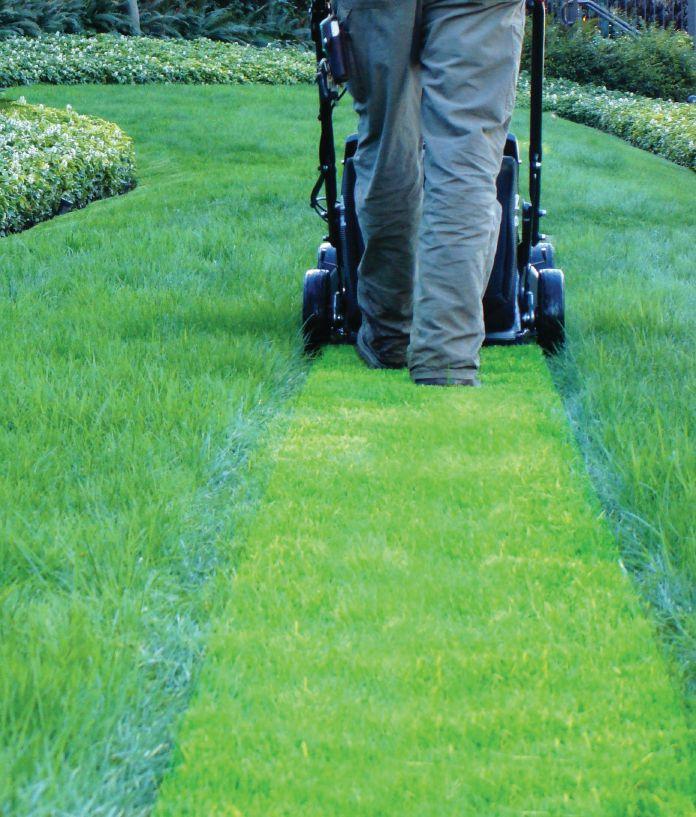
talk about what variety is best, it really depends on how you’re going to use it.”
Fine fescue and Colonial bentgrass, for example, are grown on the greens at the Old Course at St. Andrews in Scotland.
The bentgrass type provides a “backbone” to the greens during the winter months because the fescue fades away without a sufficient number of sunlight hours.
Lyons said lab tests show fine fescue can survive the least amount of sunlight the most.
“It’s not really shade tolerant or low light tolerant. It just has a muted response to shade which means it grows better in shade.”
Mowing heights are based on species and variety, he said, noting tall fescue and
THE GAME HAS NOW CHANGED

This is the season of recreation, outdoor pursuits and renewed focus on fine turf surfaces. Turf Fuel’s innovative new Vertical will surely give you a fresh edge and ensure a successful growing season.
VERTICAL™ FUEL FOR BOTH PLANT & SOIL NEW
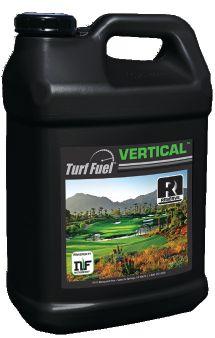
ABOVE GROUND: Anti-stress technology
• Wellness triggers
• Super efficient potassium
• Antioxidants
Growth promotion
• Improved photosynthesis
BELOW GROUND: Rooting technology
• Food for soil microbiology
• Proprietary three part organic acid blend
Improved nutrient availability
• Key sugars for plant health and microbial stimulation
• Rich carbon supply for rhizosphere
target-specialty.ca |
Mitch Davidson
Southern Alberta, Kootenays mitch.davidson@target-specialty.com 587.223.2083
Jason Hooper
Lower Mainland & Interior Bc jason.hooper@target-specialty.com 604.317.2476
Chris Paterson
Southern Alberta & Kootenays chris.paterson@target-specialty.com 403.540.0157
Eric Gratopp
Northern Alberta eric.gratopp@target-specialty.com 587.284.4744
Gregor Kowalski
Vancouver Island gregor.kowalski@target-specialty.com 250.686.3909
Josh Seibel Saskatchewan & Manitoba josh.seibe@target-specialty.com 306.861.8296
Mark Scenna Sales Manager, Canada mark.scenna@target-specialty.com • 416.458.2396
Perry Brazeau Toronto / East perry.brazeau@target-specialty.com 416.705.8006
Colin Hindle
Ottawa & Eastern Ontario colin.hindle@target-specialty.com 613.314.9711
Jason MacRae
Quebec North & West jason. macrae@target-specialty.com 514.712.8006
Mitch Guy Northern Ontario mitch.guy@target-specialty.com 705.444.9010
Joey Losito
Quebec South & East joseph.losito@target-specialty.com
819.571.1677
Craig McCutcheon
South-West Ontario craig.mccutcheon@target-specialty.com 905.351.6544
Chris Nelson
Toronto West / Niagara chris.nelson@target-specialty.com • 647.382.6868
Agronomy
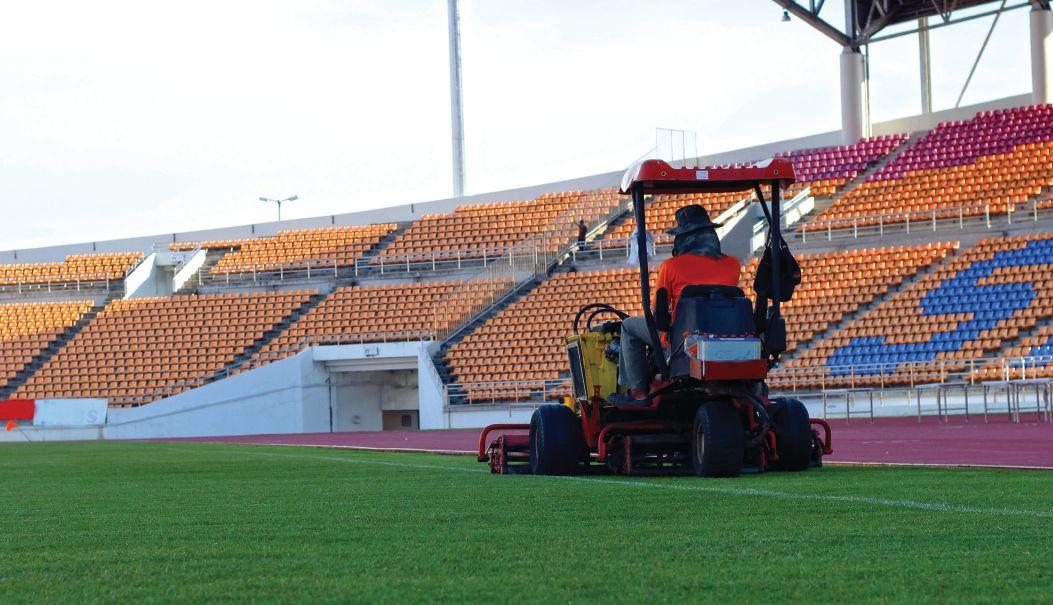
Kentucky bluegrass can be mowed fairly low, yet tall fescue can also fare well at three centimetres. Some perennial rygrasses can survive as low as a half-centimetre. Within a species, certain cultivars can be mowed lower than others.
Sports such as soccer and rugby demand playing surfaces are mowed low. Many such sports fields are grown to perennial ryegrass due to its low mowing tolerance in comparison with Kentucky bluegrass.
Lyons said if the ideal mowing height for most Kentucky bluegrasses is two inches, and if it’s taken down to a halfinch, it’s slower to recover from divoting than if it’s left to the higher height. He said Kentucky bluegrass can survive OK when mowed as low as one centimetre, but between four and 2½ centimetres it reaches a threshold where it becomes much less competitive with weeds.
“That is a big deal on home lawns and sports turf.”
Raise your mowing height
The often-heard advice to mow higher to reduce the amount of weeds is true when
the height is raised to 1½ inches from an inch, but Lyons said adjusting to two inches from 1½ inches shows no change in weed populations, according to studies.
“So if you’re mowing your sports fields or municipal parks below an inch and a half, I would say raise them up to an inch and a half at least.”
There are few parks and sports fields being mowed below two inches, he said, adding mowing at a height of about 2¾ inches isn’t going to have much of an impact on broadleaf weed invasion.
Kentucky bluegrass can be mowed low as long as there is good management and weed control that doesn’t let up. Without such control, it could impact the choice of seed that’s purchased, Lyons said.
Attributes of Kentucky bluegrass include stress tolerance and the ability to withstand winter, drought and wear. Its stress tolerance is due primarily to its rhizomes, yet mowing heights are limited and it should be blended. Because its growing points are below ground, it’s protected from winter desiccation, extremely low air temperatures and ice damage.
Although perennial ryegrass has some winter issues, it grows well, is quick to germinate, has good seedling wear tolerance, has a wide range of mowing tolerance, has endophytes which prevent feeding among chinch bugs, is ideal for overseeding and has a bunch-type growth habit. Conversely, perennial ryegrass doesn’t have the same survival ability as Kentucky bluegrass, and, at lower mowing heights, some varieties are susceptible to grey leaf spot.
There are several varieties of fine fescue. It has a muted shade response and, because of this, it doesn’t respond to shade as quickly as many other grasses and doesn’t change its growth habits. Fine fescues tolerate a wide range of mowing heights, from a few millimetres to about seven centimetres. They have a low traffic tolerance, especially in the heat. Lyons said if fine fescue is mowed on a hot day, the mower’s wheel marks will still be visible a day or two afterward. Tall fescue, on the other hand, has limited mowing heights and struggles below three centimetres. It, however, has a range of quality and growth habits,
Some sports, including soccer and rugby, demand lower mowing heights. To meet that demand, the right turf species must be present.
and has superior heat tolerance and superior growth during drought. Although it greens up early in the spring if there’s no snow mould, it tends to be slow in wear recovery. It also has moderate ice encasement survival.
The right cultivar
Choosing the right cultivar can be difficult, Lyons said, because they’re often not listed, especially in lawn and sports field mixes. Creeping bentgrass mixes, however, will almost always list the cultivar.
He said most suppliers are willing to supply whatever information is needed.
“Your relationship with your distributors and seed suppliers is crucial for making the right decisions and having success. They have a vested interest to sell you seed, but they also have a vested interest in having you be successful with the seed they sell you.”
A good way to learn more about the various varieties of seed is from the National Turfgrass Evaluation Program (NTEP), but valuable information can also be obtained from the Turfgrass Water Conservation Alliance (TWCA) and the Alliance for Low Input Sustainable Turf (A-LIST).
Because turf has no yield, it has to be assessed and brings in the human allowance to determine how it’s assessed. Such considerations include colour, tiller density and root depth.
Lyons said Kentucky bluegrass cultivars should be blended, with at least three cultivars and from different types and classifications.
“We need different types in the same blend so that they look good together.”
Each type in the mix plays a specific role, such as one being more drought resistant while another may be more dense or more aggressive. If one variety becomes susceptible to a disease such as powdery mildew a year after establishment, the others can carry through, he said.
Perennial ryegrass should not dominate a stand, Lyons said, unless there are ways to keep it alive through the winter. He suggests perennial ryegrass should account for no more than 20 per cent of the mix, even
though recommendations for a northern mix state no more than 30 per cent.
“If you start with 30 per cent perennial ryegrass in your mix after establishment, you might have 60 per cent of the tillers being perennial ryegrass in that first year.
If you get an ice event, that’s not going to be good.”
When overseeding, however, perennial ryegrass will provide a quick fill-in, good seedling wear tolerance and persistence in traffic.


Taking the road to sustainability
Sustainability is the potential for long-term maintenance of well-being, which has ecological, economic, political and cultural dimensions.
By Mike Jiggens
Sustainability” is a term heard more often today than ever before. The word has been applied to a plethora of industries, from energy to agriculture, and is also a buzz word in the professional turfgrass maintenance industry.
To take on a more sustainable approach in the turf industry, professionals must operate with a series of evaluation elements in place, says John Bladon, principal with The Chimera Group, a management, communications and consulting firm based in Guelph, Ont.
Speaking last winter at the virtually-delivered Ontario Turfgrass Symposium, Bladon said sustainability initiatives require the reconciliation of environmental, social equity and economic demands – the three Es of sustainability – but he prefers to consider the three Ps: people, plant and profit.
“If we can balance those three requirements, oftentimes we’re going to find ourselves charting a sustainable course or
sustainable path,” he said.
The planet and people – or community – are much more at the forefront, and much of the world tends to focus primarily on them, Bladon said, adding profit will follow. He cautioned, however, that dollars and cents tend to dictate everything, and it’s important not to lose sight of people and planet. We need to not only consider the price we’re paying, but the cost of what we’re doing, he noted.
In ecology, sustainability is how a biological system remains diverse and productive over time. Among human beings, sustainability is the potential for long-term maintenance of well-being, which has ecological, economic, political and cultural dimensions.
To move toward a more sustainable approach, there is need to operate with a series of evaluation elements in place, Bladon said, adding we must ask ourselves if something is sustainable and what kind of change is warranted.
Adopting a “measure it to manage it” strategy is a more reliable method for management or purchasing than by guessing, he said, recommending the “externalities,” or secondary and tertiary elements that accompany the things we do, be reviewed. Externalities can number from the few to the thousands and can include the ways products are packaged, such as in plastic or paper, or whether or not bleach or dye are involved.
Externality awareness
Being aware of the externalities associated with a decision is imperative, Bladon said. He recalled an American friend of his had influenced his golf club to purchase electric golf cars as a means of moving away from emissions-producing gasoline-powered cars. Bladon reminded his friend that electricity generated in his state was derived from burning coal.
“It’s those secondary elements tied to any decision that can impact not just us,
By balancing people, planet and profit, the road toward sustainability can be paved.

New! Bannerman Model B-IS-F145
Stone & Debris Burrier
Controls weed infestation in walking paths, warning tracks and baseball infields with the “One Pass” ground preparation for seeding or sod replacement in goal mouth areas.
Features include:
• Tractor PTO Driven - (30 to 45HP) recommended
• 28 Special Centra Rotating “Hoe” Blades Leveling
• Grader Blade on Screw Jacks
• Rear Adjustable “Net” Roller complete with Soil Scraper and Brush
• “Net” Roller can be offset to work close to fences, walls and curbs
• Working width 57”, Standard 3 Pt Hitch Cat # 1 & #2

B-MSS-1400 Multi-Star Seeder
Unique angling of middle two rotors from 0-6 degrees to allow raking and agitation of surface to incorporate seeds or dressings more effectively. Accurate stainless-steel seed metering system.
Features include:
• Seeding Width of 55”
• Long Life “Star” Seeding Blades Interlock for Self Cleaning
• Hydraulic “ON/OFF” Seed Flow Control
• Rear Drag Brush
• 3 Point Hitch Cat #1 & #2





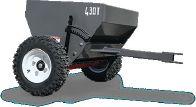
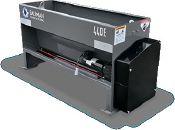



Industry Innovators
but the waste we produce.”
By using data and other elements, biases can be diminished when trying to make better decisions. It’s a directive that applies to all sectors of the turfgrass industry, he said.
Businesses that are “future fit” create value while ideally increasing the possibility that humanity and other life on earth will continue to flourish. Their goals are to reduce and refine energy use, increase the amount of responsibly sourced water, reduce waste and water use, and increase the utility of land and assets. Such businesses also increase the amount of responsibly managed resources, contribute to the resilience of communities, safeguard the health of employees and provide them with a living wage, conduct business ethically, integrate procurement standards, and build financial assets to protect their future fitness.
Within the European turfgrass industry, hardscapes in many areas are being replaced with turf, allowing for ground water to be filtered and temperatures softened, especially in heavily populated areas.
“It’s certainly a sustainable choice,” Bladon said.
Collected turf clippings and compost present revenue and reuse opportunities, and, when collected at the right time of year, capture weed seeds and improve the stand of turf.
Bladon encouraged his audience not to discount their power as product purchasers, suggesting they can promote sustainable change. They can inquire about the type of packaging used for necessary products, and perhaps select those that use non-bleached paper and cardboard, plant-based plastics and biodegradable printing dyes.
Sustainability is as much an attitude as
it is a structure-based approach, he said, and it starts with the operations and properties being managed, including golf courses, sports fields, and residential and commercial landscapes.
Turfgrass professionals must be able to effectively communicate with their superiors using language they understand, Bladon said.
“That may not be agronomy and it might not be the all the things we commonly discuss and often get excited about as professionals. We need to navigate to the language they understand to keep them on board with what we’re looking to accomplish.”
“We are also trying to foster a greater understanding of what we are trying to accomplish with our direct reports and others. You’re really developing components that are part of an experience and maximizing engagement.”

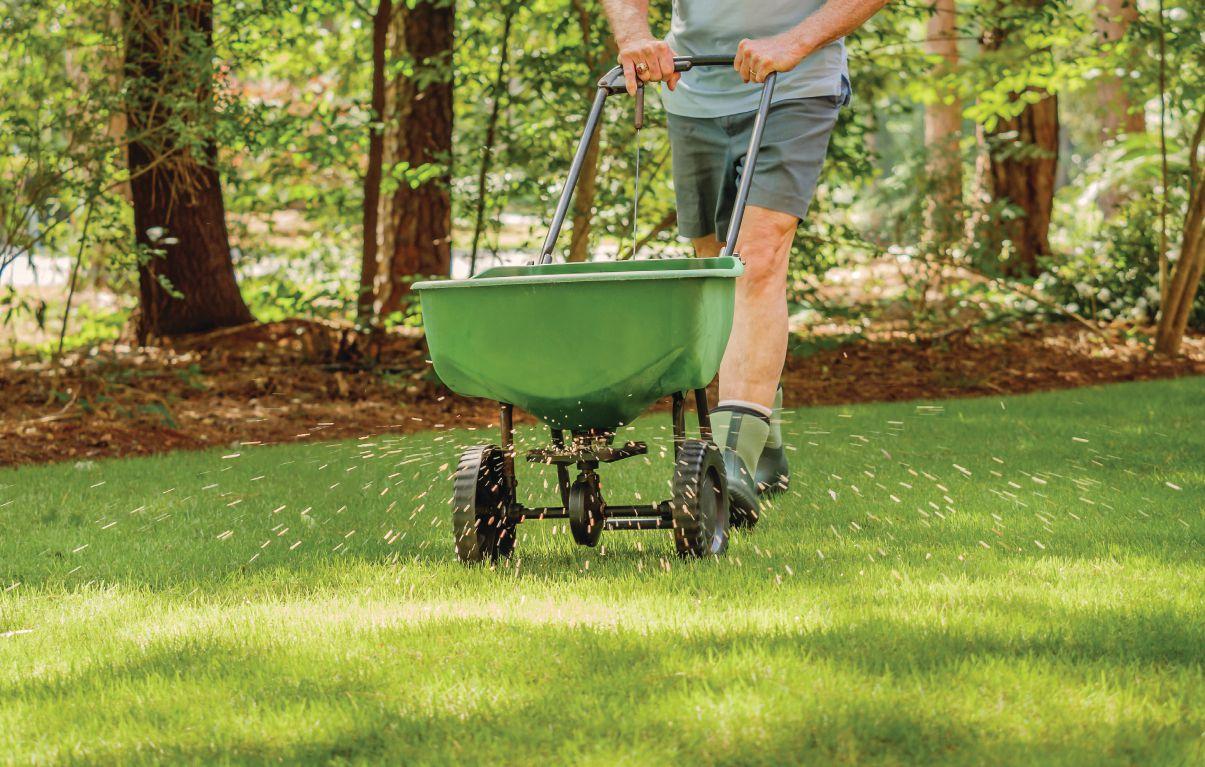
Organic lawn care: Know the difference
Customers must be informed that results may not come immediately and costs may be higher.
By Mike Jiggens
Lawn care professionals who wish to offer their customers an organic program can still achieve satisfactory results, but they’ll come with a number of challenges, a professor of turfgrass management and soil fertility says.
Dr. Beth Guertal of Auburn University in Alabama, speaking in September at Nutrite’s 10th annual Customer Appreciation Day in Guelph, said elements of organic turf management are mandated in many jurisdictions, such as in provinces where many traditional chemical weed control products are outlawed or where phosphorus use is restricted. In spite of such limitations, however, an organic program can be delivered as a feasible option, but it’s up to the professional to communicate with his customers so that they understand the desired results may not come immediately and prices could be higher.
Fertilization is relatively easy in the
delivery of an organic turf management program, she said, but added weed control tends to be more difficult. Because such inequalities exist when compared with an inorganic program, it is important the customer is educated about the differences between programs.
Customers must be informed, for example, that organic nitrogen isn’t immediately taken up by the plant. A sward of turfgrass that needs to green up and grow and heal quickly may require an inorganic nitrogen source such as ammonium sulfate or urea because the nitrogen is readily available. Urea can produce colour on bentgrass within four hours, Guertal said.
“Grass takes up and uses two forms of inorganic nitrogen – nitrate or ammonium,” she said. “If you have organic nitrogen, which is not in nitrate or ammonium form, it’s got to be converted. That happens in the soil. A wide range of soil microbes will take the organic nitrogen
– using it as their food source – and as they work on it, out the other end comes nitrate and ammonium. This is called mineralization.”
Factors affecting conversion
The rate at which microbes convert organic nitrogen into inorganic nitrogen is affected by a number of factors, including soil temperature, soil pH, water content and the carbon-to-nitrogen ratio. In colder temperatures, 20 per cent of organic nitrogen is converted to inorganic nitrogen in about 10 days. When it’s warmer, it may take about three days for 20 per cent to be converted.
A lawn care professional managing a customer’s property, reduced to using only an organic source of fertilizer when temperatures are colder and it’s wet, will have to inform the customer he’s going to have to wait a while before he sees any noticeable green-up. It could take two to three weeks for soil temperatures to reach
Lawn care customers who wish to subscribe to an organic program need to be informed that desired results may not come immediately.
Lawn care

warmer conditions, allowing the organic nitrogen to convert and allow the plant access to it.
Lawn care customers requesting an organic program are actually looking for fertilizers made by plant or animal byproducts, “and there are thousands of them,” Guertal said.
Blood meal is an organic material with a higher nitrogen content (about 12 per cent nitrogen and no phosphorus or potassium) and comes from stockyard
tankage waste. Turkey litter is another popular animal byproduct organic fertilizer.
“It’s a great thing because we’re taking what would otherwise be a waste material and we’re recycling it as a nutrient source,” Guertal said.
But, she cautioned, the long-term application of organic fertilizers can lead to an accumulation of phosphorus, and that can present a problem in areas where extra phosphorus is prohibited.

“Finding products that have no P in them is important.”
Organic fertilizers are low-analysis, she said. A guaranteed analysis tells the buyer where the nitrogen, phosphorus and potassium comes from as well as their percentages.
Urea, when applied in late winter or early spring when temperatures are still chilly, will keep the colour of turf going within two to three weeks of getting decent colour. Organic sources will take longer to achieve the same green colour, she said, because it must be mineralized.
“The organic nitrogen has got to be converted to inorganic by microbes that aren’t too interested in doing that when the soil is cold or wet.”
Challenge of weed control
The single greatest issue associated with organic turfgrass management is weed control, Guertal said. The easiest way to achieve weed control and weed prevention, she noted, is to fertilize correctly, mow at the proper height and frequency, and to not let turf get open.
Organic herbicides are almost always 100 per contact and are rarely selective,
Weed control is perhaps the greatest issue associated with organic turfgrass management. But, by fertilizing correctly, mowing at the proper height and frequency, and not allowing the turf to get open can achieve control and prevention.
“We’re taking what would otherwise be a waste material and we’re recycling it.”
she said. When spraying vinegars and fatty acid compounds, they won’t be selective and will almost always require extended applications.
Corn gluten meal, for example, is marketed as an organic pre-emergent weed control product for dandelions and, to a lesser extent, crabgrass. The typical rate of application is 20 pounds per 1,000 square feet.
The problem with that, Guertal said, is that corn gluten is a nine per cent nitrogen product which, when put out at 20 pounds per 1,000 square feet, translates to two pounds of nitrogen per 1,000 square feet.
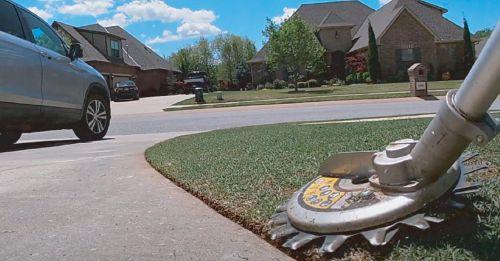
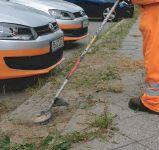




“That’s perilously close to all the nitrogen you need for the year.”
She said that where she resides in the southern U.S., applying corn gluten meal in January or February as a crabgrass control seems wasteful.
“How much grass do I have growing in January and February that’s going to use two pounds of nitrogen?”
From an environmental standpoint, Guertal said that even though it’s an organic herbicide, the amount of nitrogen that’s being co-applied could present a risk through nitrate leaching because it’s being put down at the wrong time of year.
Weed growth may be slowed down, but research suggests only 30 to 40 per cent control from the organic approach, and it will require multiple years’ worth of applications, she said, adding organic products are more expensive and don’t have residual benefits.
Adopting an organic program requires more attention to detail, she said, and professionals will have to communicate to their customers that some weeds may come along and need to be removed by hand. She also warned that a lot of “snake oil” exists in the organics market.
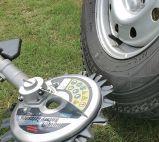













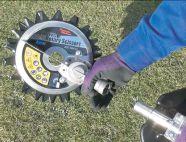





GLAGS continues domination of KEGS
Honey Cup Fall Classic sees GLAGS take 8-5 series lead.
By Mike Jiggens
The second Honey Cup Fall Classic, played in late September at London, Ont.’s Highland Country Club, produced the same outcome as its inaugural contest – a decisive win by the Greater London Association of Golf Superintendents (GLAGS) over its western rival, the Kent-Essex Greenkeepers’ Society (KEGS).
The annual match play event, sponsored by Bayer Environmental Science, saw GLAGS upend KEGS by an 8½ to 6½ score. GLAGS’ victory gave it an 8-5 series lead over KEGS. The friendly competition was previously sponsored by Syngenta from its inception in 2009 through 2019.
It was renamed last year to honour the memory of the late Paul Brown, who died in 2017 in an on-course accident at the Sarnia Golf & Curling Club, where he had been the club’s longtime superintendent. Brown had a passion for beekeeping and honey production that began several years ago when he was superintendent at the Maple Downs Golf & Country Club in Vaughan. He renewed his hobby upon his arrival in Sarnia.
Greig Barker, superintendent at Highland Country Club, said Brown “would have loved to have been here for an event like this.”
Joel Henderson, who succeeded Brown as Sarnia superintendent, fondly
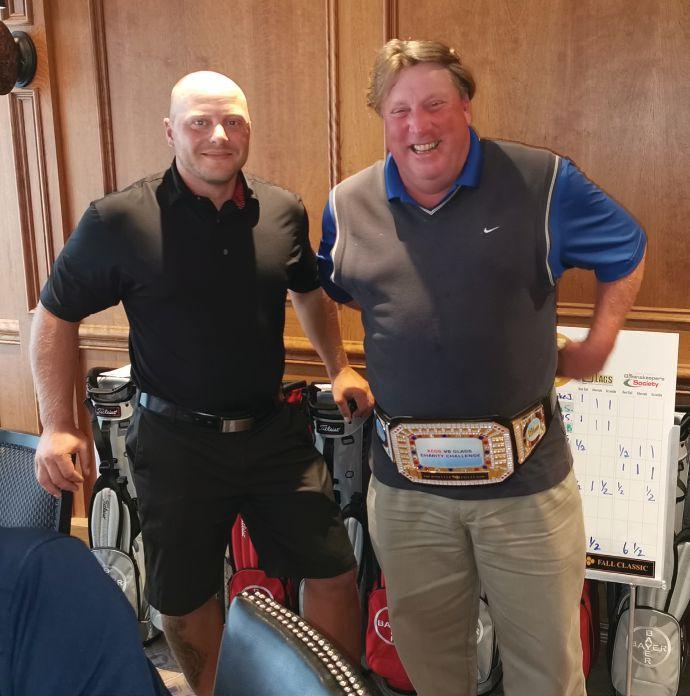
recalled their road trips together to attend various industry events
Brown’s son, Greg, will be the host superintendent for the 2022 matches at Maple City Country Club in Chatham.
“I talked with my GM about it and he said, absolutely, we’ll do it next year, so we’re already putting some things in place to know what to expect,” he said.
Bayer’s Ryan Beauchamp quipped the Honey Cup Fall Classic is a more organized event than the PGA Tour’s Canadian Open, saying the venue for the following
year’s event is already established, even as the current competition is being played.
“Hopefully we continue this (event) for a lot of years because it’s just a small, intimate group where we can do things a little bit different,” he told the collective group of 20 participants. “Bayer believes in the grassroots of supporting you guys.”
Beauchamp founded the match play event 12 years ago when he worked for Syngenta as a turfgrass specialist.
Jamie Spencer, captain of the GLAGS team, proudly wears the Honey Cup Fall Classic championship belt for another year following his team’s victory over KEGS in September. Congratulating him is Gregg Menard, captain of the KEGS team.

more our thing because we can have a big event with 150 people who don’t know half the people who are there, and you don’t expand your network,” he said. “I think with this tight group, we all get a chance to talk to each other. That’s what Highland is about. Our club is not a top tier, snobby club. This club is relaxed.”
Highland had previously been the host course in the competition’s third year.
Paul Grosvener, superintendent at London’s Forest City National Golf Club, said his club is evolving into a private club, noting memberships sold out within eight days.
AGMTurbine:Layout 1 5/25/16 11:31 AM Page 1
Following the matches, members of both teams sat down for a round table discussion of agronomic matters and on-course troubleshooting, and shared a number of humorous anecdotes.
Barker, acting as host superintendent, noted the club is celebrating its 100th
anniversary in 2022. During the more than 10 years since he’s been at Highland, he has overseen a number of important infrastructure projects, including improved drainage, irrigation and bunker work.
“Intimate get-togethers like this are
Jamie Spencer, former superintendent at London’s Westminster Trails Golf Course, has moved on to the city’s Echo Valley Golf Club, equating the transaction to a “homecoming.” Having first picked up the game there and beginning his foray into the industry at Echo Valley, he said he has come full circle and is back working alongside superintendent Scott Gardner, with whom he’s known since childhood.
Beauchamp singled out Jim Gammage, superintendent at the Ridgetown Golf & Curling Club, for his long-standing employment with the club, suggesting that anyone who has served in a management
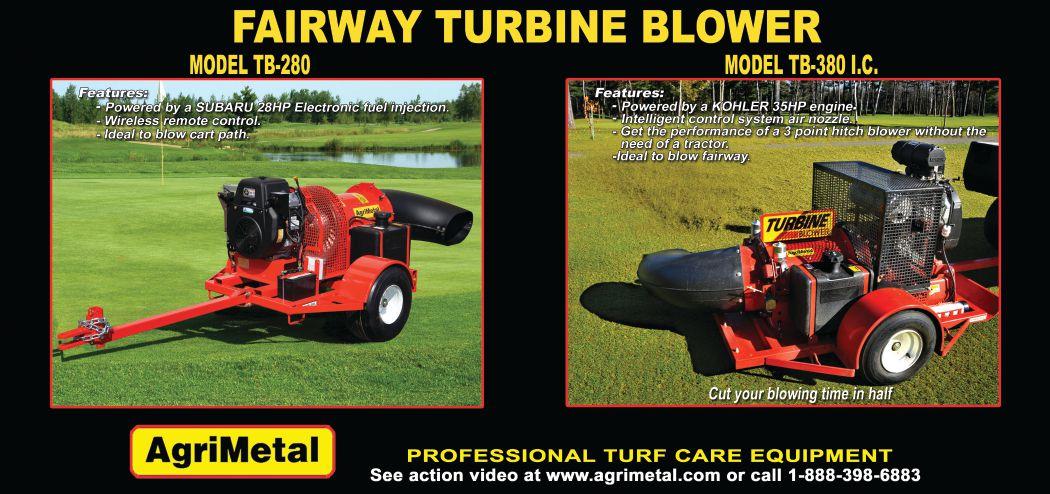
The most powerful turbines on the market.
Highland Country Club in London was in pristine condition for September’s Honey Cup Fall Classic.

“Hopefully we continue this for a lot of years because it’s just a small, intimate group”
position for more than 25 years with the same club deserves to be made an honourary member for life.
Turning toward matters of agronomic concern, Beauchamp and Bayer colleagues Tim Steen and Keith Bartlett shared various technologies that effectively control nematodes and promote bentgrass.
“Bentgrass gets attacked by nematodes like no other,” Beauchamp said.
Match results
The format of the match play competition had 10 members of each association,
Introducing the NEW Hurricane
P2000 Blower


•
divided into five pairs, going head to head against their counterparts in three separate six-hole segments: best ball, alternate shots and a scramble, with one point awarded for a win in each segment.
• Match 1: Todd Currie (West Haven Golf & Country Club) and Mike Jiggens (Turf & Rec) of GLAGS won 3-0 over Steve Hatch (Ambassador Golf Club) and Tim Steen (Bayer) of KEGS.
• Match 2: Joel Johnston (RiverBend Golf Community) and Fred Schmoelzl (Blue Water Golf Club) of GLAGS won 3-0 over Chris Andrejicka (Essex Golf & Country Club) and Keith Bartlett (Bayer) of KEGS.
• Match 3: Gregg Menard (Wildwood Golf & RV Resort) and Dan Friesen (Orchard View Golf Club) of KEGS won 2½- ½ over Kirk Stewart (Goderich Sunset Golf Club) and Paul Grosvener (Forest City National Golf Club) of GLAGS.
• Match 4: Joel Henderson (Sarnia Golf & Curling Club) and Jim Gammage (Ridgetown Golf & Curling Club) of KEGS won 3-0 over Ryan Beauchamp (Bayer) and Greig Barker (Highland Country Club) of GLAGS.
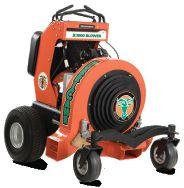

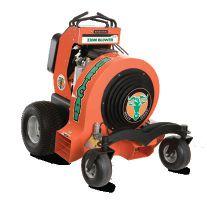
• Match 5: Jamie Spencer (Echo Valley Golf Club) and Scott Gardner (Echo Valley Golf Club) of GLAGS won 2-1 over Derek Brown (Talbot Trail Golf Club) and Greg Brown (Maple City Country Club) of KEGS.

Ryan Beauchamp of Bayer watches his putt on the 18th hole while partner Greig Barker, superintendent at Highland Country Club, looks on.
Best practices for trailering loaders
Advice for effectively hauling a loader to a job site.
By Buck Storlie
You can’t get to work with your compact track loader until you effectively haul it to the job site. Here are some tips for correct trailering.
Weight matters: If you haven’t already chosen a trailer, the operating weight of the loader should be your first consideration. Also, make sure your tow vehicle is rated for pulling weights equal to or exceeding the trailer’s rating.
Keep in mind that the trailer’s rating often includes the trailer weight, so you may have to deduct the weight of the trailer itself to get the actual load capacity. Finally, choose a trailer type. Gooseneck trailers offer high capacities, but flat decks may accommodate more vehicles.
Loading & unloading: Park on a level surface and lock the parking brake. Slowly manoeuvre off or onto the trailer, being alert to the point when the loader rocks onto and off the trailer ramps.
If available, a spotter can help guide you to make the process easier.
Got attachments? You should typically place the machine with the centre of gravity slightly ahead of the axles. Evenly balance the attachments on either side to distribute the weight.
Before hitting the road: Tape or plug the loader’s exhaust outlet if it’s facing the tow vehicle to prevent damage to the exhaust or turbocharger. Stop and check chains and tie devices occasionally to make sure nothing has moved during hauling.
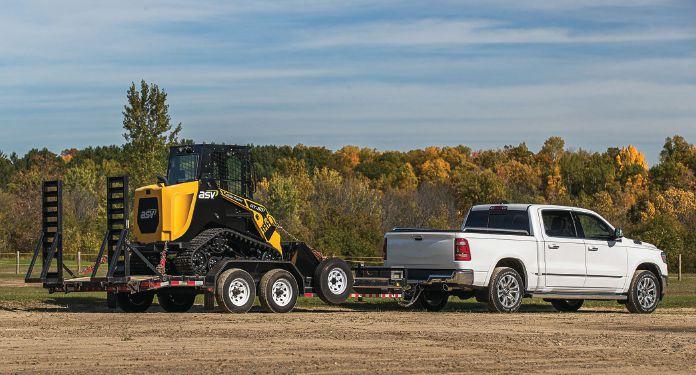

Ease-of-use features: Some loaders have design features to make your job easier. For example, some equipment features built-in tie-downs on the outside of the machine. Some other loaders have tie-downs under the loader, which are useless unless the bucket is detached.
Hauling can be even easier with some of
today’s smallest sit-in compact track loaders, which are light enough to be loaded on a trailer and pulled by a half-ton pickup. Use these tips for effective hauling so you can focus on the job at hand.
Buck Storlie is product manager for ASV Holdings Inc., a Yanmar compact equipment company, based in Grand Rapids, Minn.
Look for a machine with built-in tie-downs to making hauling easier.
The weight of the loader should be the first consideration when choosing a trailer.

2022 Conferences
By Turf & Rec
WCTA returns to in-person event
The 59th annual Western Canada Turfgrass Association (WCTA) conference and trade show is returning to an in-person event Feb. 16-18 in Penticton, B.C.
Registration for the event, to be held at the Penticton Lakeside Resort, was moving briskly after opening on Oct. 29.
Keynote speaker for the conference is Rogers Sportsnet‘s Evanka Osmak, co-anchor with Ken Reid of Sportsnet Central. She will take the stage on the morning of Thursday, Feb. 17.
Confirmed speakers and their topics include:
Thursday, Feb. 17
My neighbour, the turfie, presented by Dr. John Sorochan, University of Tennessee. Getting over being stuck down under, presented by Dr. Eric Lyons, University of Guelph.
From mowing greens to range picking: robot labour at the Victoria Golf Club, presented by Darren Collins, Victoria Golf Club.
New rules affecting the turf management industry, presented by Don Schouten, WorksafeBC.
Fraise mowing: a short cut, not a shortcut, presented by Mike DiCicco, City of Kamloops.
Hard-to-get CEC points, presented by Mario Lanthier, Crophealth Advising and Research. Provincial pesticide legislation, presented by Andreas WinsPurdy, B.C. Ministry of the Environment.
Friday, Feb. 18
What’s new in the carbon sequestration zoo? & There’s a fungus among us, presented by Dr. Clint Mattox, Oregon State University.
The return of Sagebrush: what it took to revive one of Canada’s
top 100 golf courses, presented by Neil Pilon, Sagebrush Golf Club.
On being the 2021 sports turf manager of the year, presented by Trevor Warner, City of Woodstock, Ont.
Synthetic turf: when is it time for the rubber to hit the road? presented by Doug Wournell, D. Wournell Sport Architect.
Read and follow the label, presented by Jason Pick, Olds College.
Turfgrass pests: weeds, insects and diseases and their control, presented by Jason Pick, Olds College.
A collaborative discussion on the challenges of snow mould control, presented by Clint Mattox, Oregon State University; Peter Sorokovsky, Burnaby Golf Operations; and Jason Pick, Olds College.
A collaborative discussion on the challenges of synthetic turf, presented by Doug Wournell,



D. Wournell Sport Architect; Trevor Warner, City of Woodstock, Ont.; and Dan Allen, Township of Langley.
Turf management 101, presented by Stan Kazymerchyk, Kwantlen University.
The president’s welcome will be held Wednesday, Feb. 16 from 7-11 p.m. at the Barking Parrot Bar.
The trade show reception will be held Thursday, Feb. 17 from 3-6:30 p.m. at the Penticton Lakeside Resort East Ballroom.
The trade show itself will be in the East Ballroom on Friday, Feb. 18 from 10:30 a.m. to 1 p.m., with lunch being served from 11 a.m. to 12:30 p.m.
The conference’s end keynote will be presented by John (Cullen the Comic) Cullen at 2:15 p.m. on Friday, Feb. 18.
For more information about the conference and trade show, or to register, visit https:// wcta-online.com/.





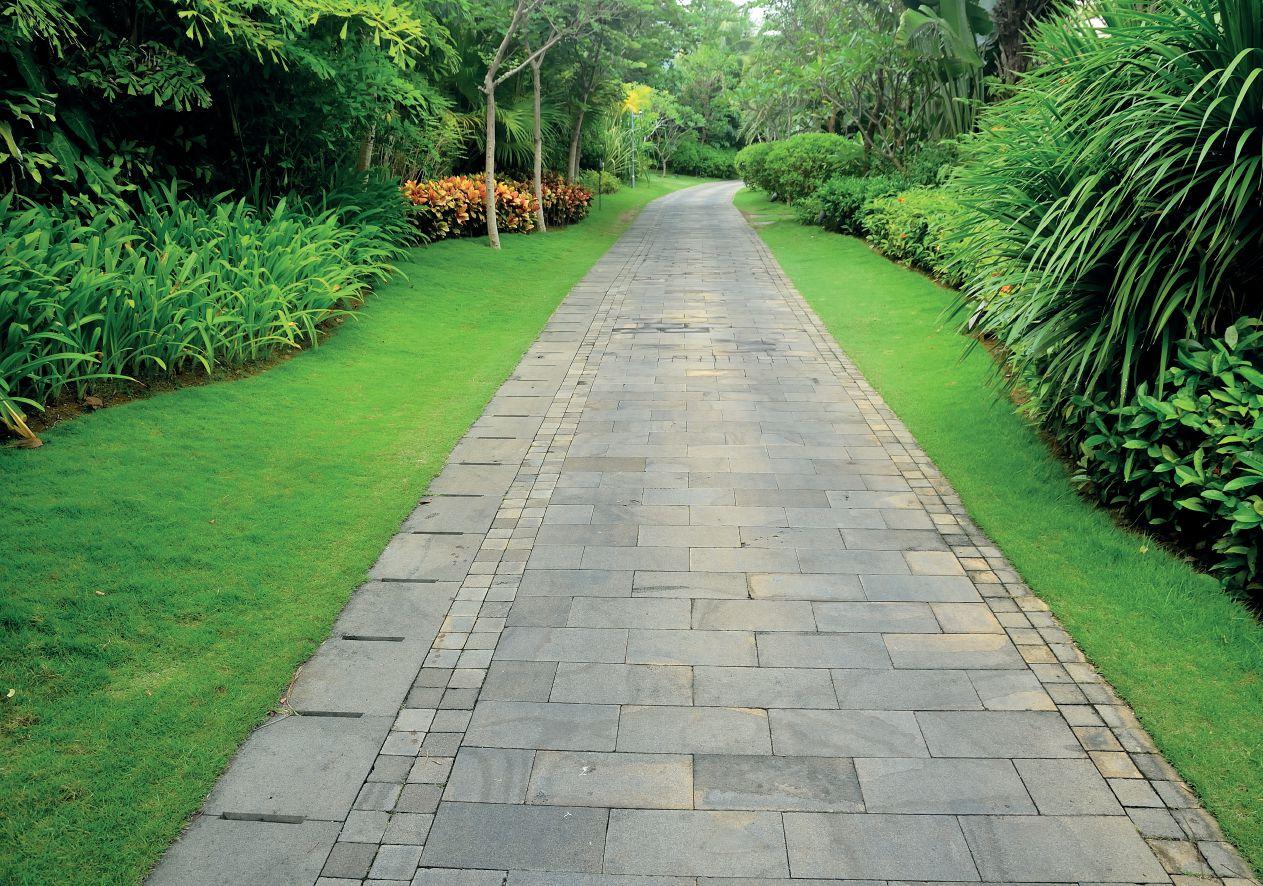












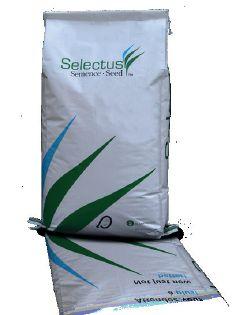






Equipment Showcase
Prevent flying debris while mowing

The innovative Power Rotary Scissors attachment from Idech is ideal for any brand of brush cutter. The one-to-20 reduction ratio and counter-rotating blades create a clean, safe, sharp cut in any use. It can prevent gravel and debris from flying and damaging trees, plants or cars in parking lots. The ability to prevent flying debris makes it an ideal brush cutter attachment for operators who work in risky conditions and wish to minimize the potential for property damage. The trimmer head is ideal for edging and precision cutting. idech.co.jp/contents/category/power-rotary-scissors/
Own Your Turf with Bobcat Zero-Turn Mowers
Iron Ant

The Iron Ant is a must have for rental operations and landscapers. Designed to move compactor plates on and off trucks the Iron Ant can also be used to move them around a job site. Landscapers will appreciate its versatility for moving just about anything that needs to be lifted such as landscape rocks, tree balls, and even pavers. Easy to use, two high torque drills power the shafts providing full four-wheel drive and skid steer like operation. reistindustries.com
Husqvarna 550iBTX

Bobcat® zero-turn mowers help you keep crews productive and profitable. The Bobcat mower lineup offers rugged durability and innovative features that help your machine work harder, last longer and give you a professional edge. With intuitive controls and commercial-grade features like the Kawasaki® FT series engine and the TufDeck™ Pro cutting system, these mowers are built to achieve perfection in less time – whether you’re a seasoned mower or a seasonal worker. With a full lineup of models to choose from, it’s easy to find the right Bobcat mower to make quick work out of big jobs.
bobcat.com
The Kubota Z781 w/ Tweel Tires

The ride-on mower of choice for landscaping professionals. Every heavy-duty component in the Kubota Z781 works to deliver best-in-class performance, allday comfort and lasting reliability to achieve consistent mowing results. The durable EFI engine powers through tough jobs. Its wide-stance design creates a low center of gravity for terrain hugging performance. The Z781 now comes with “Tweel” rear tires which are gentle on turf and remove any potential downtime due to a flat tire. It’s also equipped with dual Parker® transmissions for easy maintenance and great durability. Plus, the Z781 features smooth controls for optimal comfort and an LCD panel that provides instant engine load & performance feedback to the operator. kubota.ca
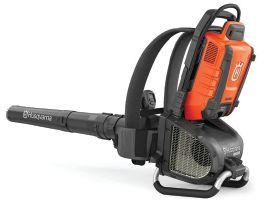
The Husqvarna 550iBTX is a powerful and ergonomic battery-powered backpack blower with impressive blowing power of 550CFM. Designed for commercial use, its low vibration and noise levels – 61 dBA at 50 feet – allow operators to work in public settings and noise restricted areas. The lithium ion powered brushless motor system of the Husqvarna 550iBTX means there are less parts to service, less downtime, and lower operational costs. And the IPX4 water resistance rating ensures that you won’t have to sacrifice productivity or flexibility. husqvarna.com/ca-en/products/leaf-blowers/550ibtx/
The
Max-Snow

snow blower from Agrimetal offers high performance under the worst conditions. Developed in conjunction with professional snow removal contractors, it has been designed to increase productivity as a heavy-duty, light and more manoeuvrable snow-clearing machine. It is also more efficient than other two-stage snow blowers, enabling snow to be removed faster. The frame’s structure is made of high-quality steel. The highstrength QT-400 steel is used in strategic areas to increase structure rigidity while reducing overall weight. The design of the snow deflector makes it virtually impossible to clog the chute, even under wet snow conditions.
agrimetal.com/en/max-snow-snow-blower
Equipment Showcase

Bannerman’s “Easy Load” Truck Loading Ramp (B-TLR) is easy to install with absolutely no welding required! It is powder coated black for durability during the winter, can easily be swapped between ramp and tailgate, has a universal fit for most major trucks, is lightweight constructed that is both tough and durable, and features spring-assisted folding. It can be used to load any and all equipment from large to small. Additionally, it can be used to load ATVs, motorcycles, furniture, appliances and more. New is a two-foot extension kit that is available and extends length of the loading ramp from eight feet to 10 feet. bannermansportsturfmagic.com
Bauman Drop Spreaders - 1140P
Bauman Drop Spreaders deliver uncompromised product quality. The spreaders prevent waste and property damage with the most accurate de-icing equipment on the market. Bauman drop spreaders are available with hydraulic, PTO or electric drives. Options include hopper extensions, galvanized or vinyl covers and a number of mounting brackets to fit most makes and models of compact tractors and skid steers. Backed by a tradition of quality for over 40 years and with 10 models to choose from, Bauman drop spreaders can cover all your de-icing needs. baumanmfg.com
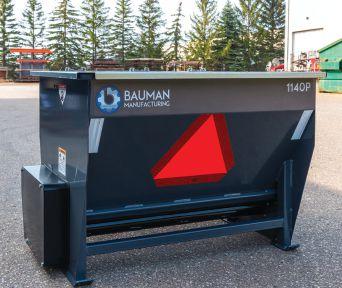
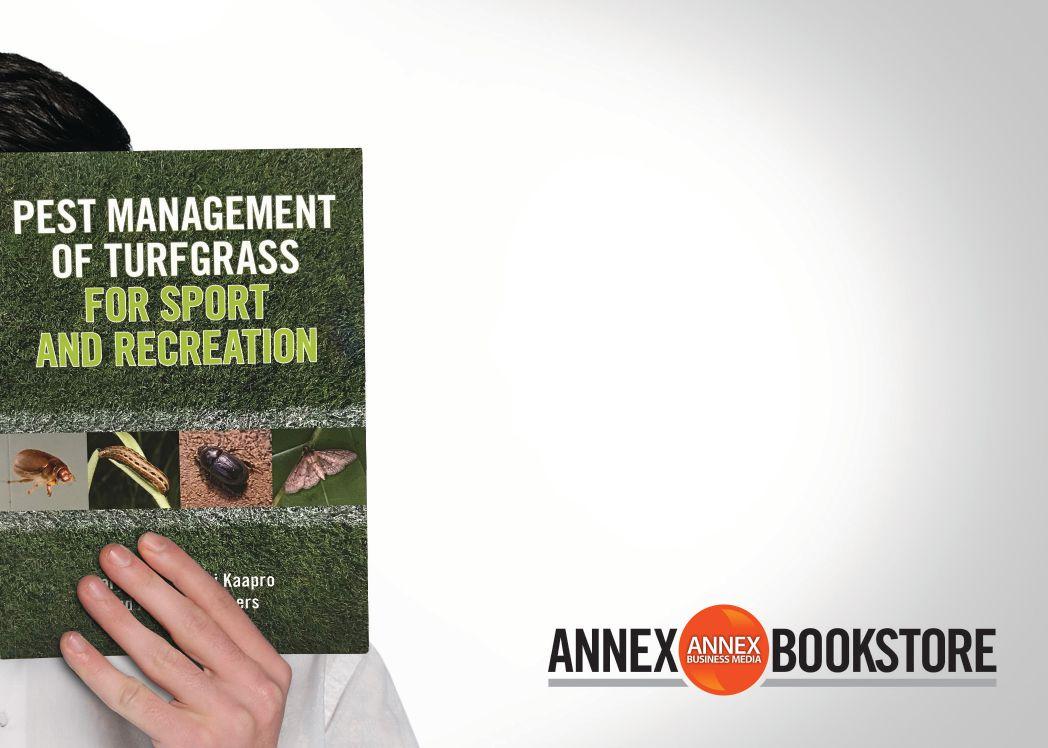

Health & Safety
By CCOHS
Get a safe handle on winter equipment
The annual signs of winter are inevitable: the snow starts to fall, the temperatures hit below freezing, and the chill can be felt from our toes to our nose. As the seasons change, it’s important to be prepared and adapt the way we work outdoors. Whether it’s wearing the appropriate layers, using seasonal equipment, or being mindful of surroundings, outdoor work is heavily impacted by the changing season.
How do you keep your crew safe and thriving during these cold winter months? If your workplace has an existing health and safety program, including a winter safety plan can help give everyone the information and tools needed to prepare accordingly. A winter safety plan should include risk assessments, equipment inspections, safe handling tips, emergency procedures, and training.
Risk assessments
Conducting a risk assessment can help identify hazards that have the potential to cause harm. For example, when using a snow thrower (or blower), workers may encounter debris, branches, or loose gravel which can be a risk to workers and the equipment. To complete the risk assessment, analyze and evaluate each hazard associated with the task and determine the risk’s likelihood and severity.
Once the risk has been assessed, determine appropriate controls to eliminate the hazard or reduce the risk when the hazard cannot be eliminated.
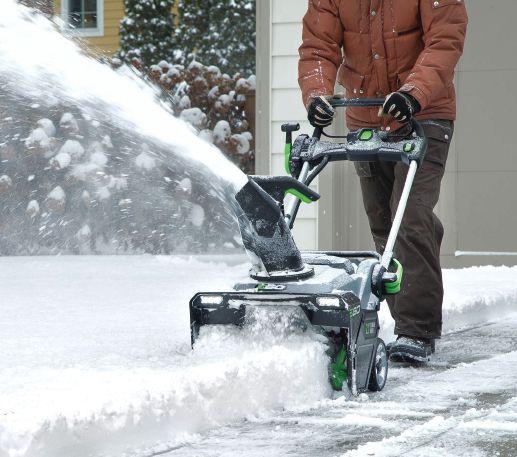
In this case, ensuring that workers clear the area and making sure no one is in the line of fire can help reduce the risk of injury.
Equipment inspection
Another step to include in your winter safety plan is to inspect and assess all snow and ice management equipment prior to the start of the season. This will help with your risk assessment to identify potential hazards and controls, which in turn may help prevent incidents, injuries, and illnesses.
Preventive and pre-season maintenance is also imperative for optimal performance. Due to the nature of seasonal equipment, by the time winter starts again, a lot of it has not been used for months. Inspecting equipment prior to its first use can help determine if any repairs or maintenance are necessary, before the equipment is needed.
Workers should also make sure to conduct a pre-oper-
When operating winter equipment, workers should understand the functions of all controls, how to operate them, and how to stop in an emergency.
ational or circle check before using any equipment to detect damage, leaks, and other issues that may affect the safe use of the machine such as fluid levels, attachments, tires/tracks, back up alarms, and lights.
Safe handling
Make sure workers are prepared to handle all snow and ice removal equipment safely. Provide them with adequate time to warm up their muscles and to work at a pace that is manageable and safe. Also, are they dressed appropriately for the weather conditions and the task at hand? Are they using proper technique when lifting or pushing equipment while
keeping in mind that the ground may be slippery?
Emergency procedures
Workers should understand all procedures related to reporting incidents, providing first aid, and receiving medical care. These procedures should be clear and accessible so that everyone is prepared in the event of an emergency.
For each shift, at least one trained person should be assigned the responsibility of attending to emergencies. Each jurisdiction has specific requirements relating to first aid, so always verify the legislation for a first aid provider or attendant. While working in the cold, consider having a buddy system in place as workers should look out for one another and be alert for the symptoms of hypothermia and other cold injuries. If they must work alone, an effective and reliable means of communication, check-in procedures, and other controls to alert others in the event of an emergency should be established.
Education and training
In addition to examining all equipment prior to use, it’s crucial that workers know how to handle the equipment safely during the winter. Make sure all workers receive the appropriate training and instruction for the assigned tasks.
Include guidance on how to inspect all equipment before use and reference the operator’s manual and safe work procedure for the safe handling and operation of the equipment during training.

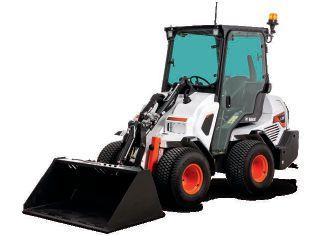
Take the extraordinary snow removal capabilities of Bobcat ® equipment into small lots, sidewalks, driveways and other places where a maneuverable machine is a must. Plus, stay comfortable in cold weather with an optional enclosed, heated cab. Small articulated loaders are available now at your local Bobcat dealer.







